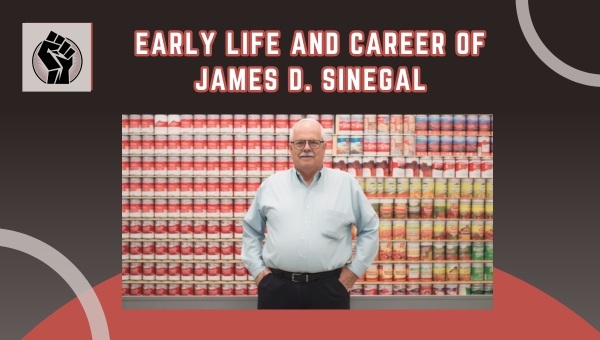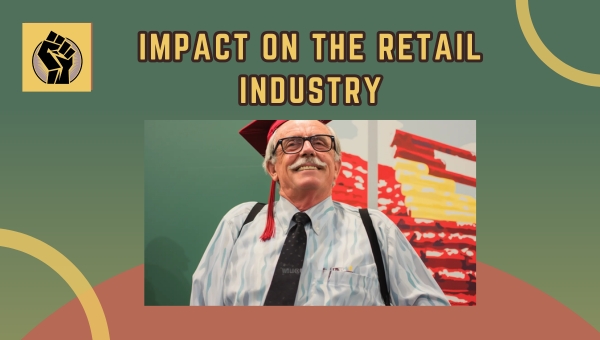It’s the early 1980s, and a young entrepreneur named James D. Sinegal is about to change the retail game forever. Armed with a vision for a unique shopping experience, he co-founded a company that would not only offer low prices but also redefine employee and customer satisfaction.
This company was Costco. James D. Sinegal Costco is not just a name; it’s a testament to innovative thinking and a commitment to quality. As we journey through this fascinating tale, we’ll explore how Sinegal’s groundbreaking approach left a lasting impact on the retail industry and set a new standard for businesses everywhere.
Early Life and Career of James D. Sinegal
James D. Sinegal, born on January 1, 1936, in Pittsburgh, Pennsylvania, embarked on his retail career at 18. His journey began as a grocery bagger at FedMart, where he swiftly advanced to the role of executive vice president.

This early experience was pivotal in shaping his business ethos, which emphasized customer and employee satisfaction over mere profit margins. Sinegal’s dedication to these principles was further honed during his tenure at Builders Emporium and the Price Company.
His roles there allowed him to refine his skills in merchandising and operations. In 1983, alongside Jeff Brotman, Sinegal co-founded Costco Wholesale Corporation. Their vision was clear: to revolutionize the retail industry by offering high-quality goods at low prices through a membership model. This innovative approach set the stage for Costco’s future success, reflecting Sinegal’s commitment to value and quality.
Founding of Costco
The inception of Costco marked a pivotal shift in the retail landscape, offering a fresh approach to how consumers shopped. Under the guidance of James D. Sinegal, the company’s vision and strategy were meticulously crafted to ensure success. Let’s delve into the early days of Costco, exploring the foundational goals and the hurdles it overcame in its path to growth.
Initial Vision and Goals
James D. Sinegal’s vision for Costco was both innovative and ambitious. He aimed to create a unique warehouse model that focused on providing low prices and high-quality goods exclusively for members. This approach was designed to revolutionize retail shopping.
His primary goals included:
- Eliminating unnecessary costs by keeping store decor and staffing minimal.
- Focusing on value to ensure customers received the best deals available.
- Building a loyal customer base through exceptional service and a carefully curated product offering.
These goals were the cornerstone of Costco’s early strategy, setting the stage for its future success in the competitive retail market.
Early Challenges and Growth
In its early days, Costco faced numerous challenges that tested its resilience. However, through strategic planning and determination, it managed to carve out a significant presence in the retail industry.
Here are some of the obstacles and strategies that defined its growth:
- Slow initial sales, which required innovative marketing strategies to draw in customers.
- Competition from established retailers pushes Costco to develop unique selling propositions.
- Logistical hurdles during expansion, as the company sought to open new locations rapidly.
Despite these challenges, Costco’s commitment to its founding principles and strategic decisions enabled it to grow steadily, laying the groundwork for the expansive network it enjoys today.
Also Read: S Truett | The Visionary Behind Chick-fil-A’s Success
Leadership Style and Strategies
When exploring the leadership style and strategies of James D. Sinegal at Costco, one finds a focus on employee welfare, customer satisfaction, and innovative business practices.

His approach was centered on creating a positive work environment and ensuring excellent customer experiences. Let’s delve into the specifics of his methods.
Focus on Employee Welfare
James D. Sinegal placed a strong emphasis on employee welfare, believing it was a critical component of a successful business.
His strategy included:
- Competitive Wages: Sinegal ensured that Costco employees received salaries above the industry standard, which helped in reducing employee turnover. This approach not only motivated staff but also fostered loyalty.
- Comprehensive Benefits: Over 90% of the workforce had access to health insurance and other benefits, showcasing Sinegal’s commitment to their well-being.
- Respectful Culture: By cultivating an environment of respect and appreciation, employees felt valued and were more inclined to provide excellent service to customers. This culture was a testament to Sinegal’s belief in the importance of employee satisfaction as a business driver.
Commitment to Customer Satisfaction
Customer satisfaction was a cornerstone of Sinegal’s business strategy at Costco.
Key practices included:
- Listening to Feedback: Regularly gathering and acting on customer input to refine product offerings and store operations.
- Maintaining Low Prices: Implementing a strict policy on markup limits to keep prices affordable for customers.
- Welcoming Environment: Designing stores to be inviting and easy to navigate, enhancing the overall shopping experience.
Innovative Business Practices
Sinegal was known for introducing innovative practices that distinguished Costco from its competitors.
His strategies involved:
- Membership Model: Offering customers bulk purchasing options at discounted rates through a membership system, which created a sense of exclusivity and value.
- Streamlined Operations: Adopting a no-frills shopping experience to cut down on operational costs without compromising on quality.
- Selective Inventory: Focusing on a limited range of high-demand products, which helped in optimizing inventory management and meeting customer needs effectively.
James D. Sinegal’s leadership style and strategies at Costco reflect a deliberate focus on both people and process, fostering a business model that prioritizes employee contentment and customer satisfaction through thoughtful innovation.
Impact on the Retail Industry
James D. Sinegal’s approach to retail has left a significant mark on the industry. His strategies not only propelled Costco to success but also prompted other retailers to reconsider their practices. Let’s explore how his innovative methods have influenced competitors and contributed to cost leadership.

Influence on Competitors
James D. Sinegal’s practices at Costco have had a noticeable impact on competitors in the retail sector. His emphasis on employee welfare inspired many companies to rethink their own policies and prioritize the well-being of their workforce.
This shift led to more competitive compensation packages and improved working conditions across the industry. Additionally, the membership model he championed encouraged other retailers to adopt similar strategies, creating a new standard for customer engagement and loyalty.
Sinegal’s focus on high-quality products at low prices pushed competitors to enhance their value propositions, ultimately benefiting consumers with better options and pricing.
Contributions to Cost Leadership
Sinegal played a pivotal role in establishing cost leadership strategies within the retail landscape.
His methods included:
- Streamlining Operations: By minimizing waste and optimizing processes, Costco managed to reduce overhead costs significantly.
- Innovative Pricing Strategies: Sinegal’s approach ensured that Costco maintained a competitive edge without compromising on quality, setting a benchmark for others to follow.
- Efficient Inventory Management: Focusing on a limited selection of high-demand items allowed Costco to negotiate better deals with suppliers, further driving down costs.
These strategies not only solidified Costco’s position as a cost leader but also encouraged other retailers to adopt similar tactics, reshaping the retail industry as a whole.
Also Read: 9 of The Famous Polymaths Who Transformed the World
Legacy and Philanthropy
James D. Sinegal, co-founder of Costco, left a lasting impact that extends beyond his tenure at the company. His dedication to ethical business practices and community support continues to inspire many.
After stepping down from his leadership role, Sinegal’s influence remained strong, both in business and philanthropy. Let’s explore how his legacy shapes the world today.
Retirement and Continued Influence
Even after retiring, Sinegal’s presence in business circles remains significant. His ongoing contributions include:
- Advisory roles: Offering guidance to organizations focused on ethical business practices.
- Public speaking: Sharing valuable insights on sustainable and responsible business models.
- Industry impact: His retirement hasn’t diminished his impact on industry trends, as many still look to his strategies for inspiration.
Charitable Activities and Contributions
Beyond retail, Sinegal’s philanthropic efforts have made a mark on society. His contributions are evident in various areas:
- Educational donations: Significant financial support to institutions promoting learning and growth.
- Health initiatives: Investing in programs that improve health outcomes for communities.
- Community support: Actively funding and participating in initiatives that benefit local communities, showcasing his commitment to social responsibility.
FAQs
Who is the founder of Costco?
Costco Wholesale Corporation was co-founded by James D. Sinegal and Jeff Brotman. Their combined vision led to the creation of a retail model that focused on providing quality goods at low prices through a membership system.
Where was Costco founded?
Costco was founded in Seattle, Washington. The first warehouse opened its doors in 1983, marking the beginning of a new retail experience that quickly gained popularity.
When James D. Sinegal was Born?
James D. Sinegal was born on January 1, 1936. His early experiences in the retail industry shaped his innovative approach to business, contributing to his success as a co-founder of Costco.
Conclusion
James D. Sinegal’s journey with Costco is a testament to his visionary leadership and commitment to both employees and customers. His innovative approach to retail, emphasizing employee welfare and customer satisfaction, has left a lasting impact on the industry.
By prioritizing quality and value, Sinegal created a successful business model that continues to influence retail strategies today. His legacy extends beyond business, with philanthropic contributions reflecting his dedication to social responsibility. To sum up, Sinegal’s principles remain a guiding force in retail.
If you found this article insightful, explore more engaging content on our site to discover stories of other influential leaders!





